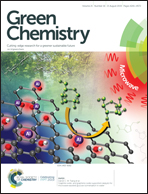Electrochemically dehydrogenative C–H/P–H cross-coupling: effective synthesis of phosphonated quinoxalin-2(1H)-ones and xanthenes†
Abstract
An efficient electrochemical approach for the C(sp2)–H phosphonation of quinoxalin-2(1H)-ones and C(sp3)–H phosphonation of xanthenes has been developed. The chemistry was performed in an undivided cell under constant current conditions and features a wide range of substrates, up to 99% yield and it is free of transition-metal catalysts- and external oxidants, thereby providing a straightforward approach for dehydrogenative C–H/P–H cross-coupling. In addition, control experiments disclose that some of the reactions may involve a radical pathway.



 Please wait while we load your content...
Please wait while we load your content...